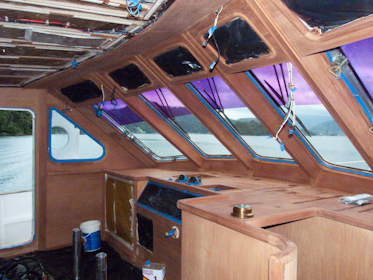Heat, Air Movement, and Drying Time
Finishers discuss the use of heaters and fans to reduce re-coat wait times. February 21, 2011
Question
I'm slowly converting all of our finishes to waterborne products. Now that we are entering the winter and the weather is not cooperating as much, what are you doing to decrease the drying time between coats on your waterborne finishes? I've seen dryers, IR lamps, heaters, etc. for sale and wonder if they're worth spending the money on. Or, as I read in another post, should I just use a regular fan to get the air moving?
Forum Responses
(Finishing Forum)
From contributor P:
Winter should help, as the humidity is generally lower. Keep the temps up in the 60s or higher. Heat lamps work, but check with your coatings supplier for specific recommendations.
From contributor D:
With waterborne, air flow is crucial. You need some heat, but it doesn't react with heat like solvent-borne products do. Lots and lots of air flow seems to be the key with waterbornes. At least 65F, but after you've achieved that, the movement of air is what really gets the drying accomplished.
From contributor T:
We use an IR heater in our woodshop. We discontinued using forced air because of airborne dust. What's nice about IR is it drops the relative humidity and is a source heat. I use it only when I need it. It drives the water off and sets the finish enough so we can sand quicker and recoat faster. The other alternative is using a product like accelerator for waterbase finishes. It carries the water out of the finish faster than regular solvents. We have it for shops in ultra humid areas such as the deep south or areas along the coastal regions.
From the original questioner:
Thanks for your responses. I'm in Southern California, but it's not always so sunny like you may have been told. While I'm not located in the desert or on the coast (somewhat inland), we have our share of damp and drizzly days or a marine layer that increases our humidity (currently 50% inside and high 72% outside).
What are you specifically doing to increase your air flow and are you only doing it on every coat except the final coat to eliminate/reduce debris in the finish? Are you using just ordinary household box fans or something else to increase the air flow?
Contributor T, where did you find an IR heater for the purposes discussed here? Do you have any suggestions, hints or tips for a more successful outcome when using an IR heater?
From contributor P:
I'm not doing anything to move more air around. I run a dehumidifier and keep the shop warm when spraying. I get impatient with the dry times, but I've learned to live with it.
From contributor T:
I purchased the unit from the WW Grainger catalog. The brand is made by Fostoria. They sell a wide variety of heating and air units. Small to large sizes.
From contributor D:
I have a booth, so there already is a lot of airflow.
From contributor L:
We've been waterborne finishing for over 15 years. We use two industrial pedestal fans to move lots of air. Curtain off an area with plastic sheeting where you can raise the temperature to at least 65F (more makes it work faster). Normal dry to sand time is about 20-30 minutes, so just have a drying area that will accept that much product to be rotated through. Don't put on thick coats of WB finish. Three light coats will go faster than two heavy ones, and look better.
From contributor J:
As others have said, air flow is the key here. What I ended up doing for water based jobs was changing my production methods from a mass layout and spray technique to more of a stick and move approach. I built a 400 square foot drying room with minimal heat, but good airflow provided by a few small but strategically placed fans. Now I spray cabinets one at a time and doors by the rack, moving everything into the dry room immediately after spraying. I try to do a bunch of spraying before lunch and by the time I get back, everything in the room is dry enough to sand and recoat.
